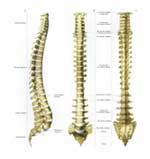Back Injuries Have Many Causes, Which Insurers Minimize
Back Sprain, Strains, and Spasms
A sprain is an injury where the ligaments are stretched beyond their normal capacity, and sometimes torn. A strain is an injury to a muscle in the same manner. Both conditions are painful, and often cause the involved and surrounding muscles to spasm so as to keep the spine still and prevent further injury. Muscle spasms can be so intense that they reverse the normal curvature of the spine (lordosis), as seen on x-rays and other imaging studies. This type of injury is often referred to as whiplash when it involves the neck, and is quite common in car crashes, particularly in rear-end collisions.
Unfortunately, insurance companies minimize back injuries such as back sprain/strains, referring to them as “soft tissue” injuries, and offering very little to settle. They will hand-pick doctors to examine the injured person and testify that all soft tissue injuries heal within a matter of weeks. The truth of the matter is that healing time depends on many factors, including age, conditioning, underlying disease, body size, body type, sex, prior injuries, etc. Only an experienced personal injury attorney knows how to deal with these frivolous arguments.
Spinal Fractures
 Spinal fractures generally occur in one of four areas of the vertebra – the vertebral body (the part that holds the disks), the articular process, the transverse process, or the spinous process. Spinal fractures can be quite painful, but usually resolve with time. People with osteoporosis or osteopenia (reduced bone density) can experience multiple fractures in a single vertebra (“crushed vertebrae”), which can be more serious and cause complications. Spinal fractures generally occur in falling injuries or severe car crashes.
Spinal fractures generally occur in one of four areas of the vertebra – the vertebral body (the part that holds the disks), the articular process, the transverse process, or the spinous process. Spinal fractures can be quite painful, but usually resolve with time. People with osteoporosis or osteopenia (reduced bone density) can experience multiple fractures in a single vertebra (“crushed vertebrae”), which can be more serious and cause complications. Spinal fractures generally occur in falling injuries or severe car crashes.
Insurance adjusters minimize spinal fractures, particularly those not involving the vertebral body. Moreover, of the fractures involving the vertebral body, most are compression fractures – essentially a crushing of the bone (think of a corn flake that has been stepped on). Underlying disease, such as osteoporosis, can make these fractures more likely, and more serious. However, the law protects folks with such underlying conditions, also known as prior infirm conditions. Experienced accident and injury attorneys know how to apply the law to fully compensate their clients.

